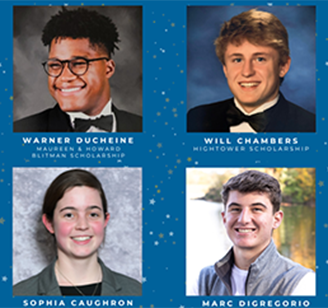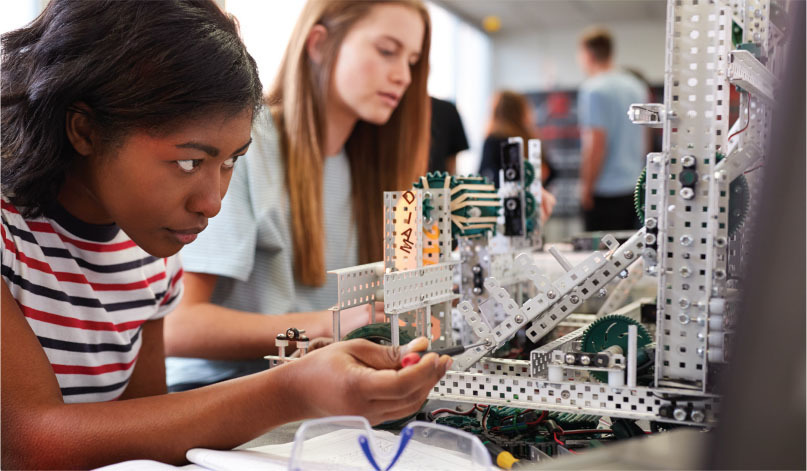October 2014
COMMUNITIES: EDUCATION
Gathering STEAM
The movement to add the arts to STEM is gaining momentum.
The STEM acronym has gained a lot of attention recently—but a modified version is growing in popularity. In K–12 and higher education institutions across the country, STEM is turning into STEAM, with the arts blended into science, technology, engineering, and math.
As advocates emphasize, adding the arts to STEM curricula and outreach can teach students to solve problems creatively, collaboratively, and across disciplines. In addition, proponents believe broadening the focus can attract and engage a more diverse set of learners. Ultimately, these benefits could improve the country’s ability to innovate and compete.
Interdisciplinary learning isn’t a new idea, but the STEAM movement has been gaining ground since the mid-2000s. Georgette Yakman, former technology teacher and owner of educational consulting firm STEAM Education, says she was the first to introduce the concept.
Yakman believes she has “engineered education,” (particularly in K–12) by creating not a new curriculum but a new framework for learning that incorporates language, physical/manual, fine, and social/liberal arts with the traditional STEM topics. “You can’t keep putting everything in a science and math perspective and expect you would attract more [students] than you are already attracting,” she says.
For instance, she suggests schools pick a theme (such as transportation) that teachers of various subjects can design lessons around. She’s also developing a Wikipedia-like platform for lesson plans.
In higher education, the Rhode Island School of Design has been an early advocate of the STEAM movement, driven by former president John Maeda.
According to the school’s director of government and external relations, Babette Allina, RISD adopted STEAM as a mission in 2011 to help demonstrate the importance of art and design.
RISD is pushing the idea forward in the policy arena. The school worked with the office of House Representative James Langevin (D-RI) on a resolution “expressing the sense of the House of Representatives that adding art and design into Federal programs that target the Science, Technology, Engineering, and Mathematics (STEM) fields encourages innovation and economic growth in the United States.” It was last referred to committee.
RISD also helped launch the bipartisan Congressional STEAM Caucus, which advocates for policy changes. It now includes more than 60 members from 26 states, according to Allina.
She says she has seen the STEAM movement really “catch fire” in the last year, and credits “maker” culture and industry interest as drivers. Creativity is a competency that companies want, she says.
A 2008 study by Michigan State University researchers found that Nobel laureates in the sciences were 22 times more likely than scientists overall to participate in the performing arts. Involvement in other types of arts also appeared more frequently in that population.
RISD shares a dual degree program with Brown University and offers interdisciplinary courses such as “Visualizing the Natural Sciences.” The institutions have both launched STEAM student groups and collaborate on some activities.
Michelle Site is the founder of the Brown group, which puts on speaker series and workshops; conducts outreach with elementary and middle schools; and has been helping to start similar groups at MIT, Yale, Cornell, and Princeton.
She defines STEAM as an interdisciplinary learning effort that combines the practical tools and rigor of STEM with the inventiveness of the arts. “In the arts and sciences, in the end we’re just curious,” says Site, who graduated with a biology degree and also paints and draws. “We want to solve problems and push things in new directions.”
Victoria Wu, a Brown senior, is the 2014–15 director of the STEAM group. She has a double concentration in materials engineering and visual art, with a focus on bioengineering and medical product design. Wu emphasizes the need to consider aesthetics in industrial and product design as well as the benefit of knowing material properties.
“Most of the scientists and engineers that I’ve encountered are passionate about what they do, and I find what they do very beautiful,” she says. “They are in fact artists, just in a different way.”
Wu explains that the students from different majors who participate in Brown STEAM’s hackathons, makeathons, and prototyping workshops want a venue that allows them to blend their interests, as well as collaborate with others.
She believes the attitude that the technical and aesthetic can’t learn each other’s skills and roles is antiquated. “I think more and more people are catching on to that,” she says.


 Volunteering at NSPE is a great opportunity to grow your professional network and connect with other leaders in the field.
Volunteering at NSPE is a great opportunity to grow your professional network and connect with other leaders in the field. The National Society of Professional Engineers (NSPE) encourages you to explore the resources to cast your vote on election day:
The National Society of Professional Engineers (NSPE) encourages you to explore the resources to cast your vote on election day: STUDENTS COLLABORATE AT THE MARCH 2014 “FROM THE BOTTOM OF MY FUEL CELL” WEARABLE TECHNOLOGY PROTOTYPING WORKSHOP HOSTED BY THE BROWN UNIVERSITY STEAM GROUP.
STUDENTS COLLABORATE AT THE MARCH 2014 “FROM THE BOTTOM OF MY FUEL CELL” WEARABLE TECHNOLOGY PROTOTYPING WORKSHOP HOSTED BY THE BROWN UNIVERSITY STEAM GROUP.



